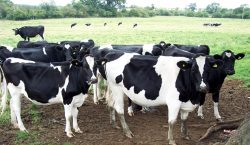


LEGEND places the origins of coffee centuries ago in Ethiopia — where a lonely goatherd noticed how lively his goats were after eating the bright red berries on a certain bush. After chewing the berries himself he experienced the same surge of energy. His wife urged him to talk to the monks who straightaway threw the sinful plant into the fire — whereupon the enticing aroma drew the other monks out of their cells.
Beans were raked out of the fire, ground up and turned into a drink which kept the holy men up all night with renewed energy for their devotions! It wasn’t quite so easy for me to turn my first coffee berry harvest into something drinkable. A lone bush flourishes at the bottom of the vegetable garden but until this year has produced mainly shiny, luscious leaves.
Suddenly its branches were laden with scarlet berries and I decided to have a go at processing my own coffee. An internet search revealed that only the brightest reddest berries should be picked. Some were already dry, brown and hard so I left those and picked the red ones — still with a juicy, fleshy outer skin.
Advice now varied. One recommendation was to dry the berries in the sun. Another said they should be soaked first and then put through a pulper. Not having a pulping machine I put together an ad hoc drying tray and had left them out for a couple of days before I bumped into a friend with some home growing experience.
She told me it was impossible to get the skins off once they were dry and hard and that I should soak them. Rushed home to plump them into a water bath and after a couple of days they started to bubble and ferment. Feared I had left them too long but the skins came off easily although it was a slow process squeezing out the hard seeds and took me several hours to de pulp my berries.
Weather was sunny and warm — so good conditions for drying and the seeds shrank and changed colour turning a greenish gray. But there are several layers before we get to the inner coffee heart! I was grateful to a visiting friend who kept me company while we broke our nails removing the tough outer skin.
A couple more days in the sun and rubbing the berries together loosened the final husk which could then be winnowed in a basket like grain.
Final stage was roasting – which I did in a wok over a gas-flame – worried all the time that it was going to burn. At last – the enticing coffee smell. After grinding, my harvest yielded a precious 250grams – refreshingly fragrant with a mocha flavour. Very satisfying.
Coffee drinking remains highly ceremonial in Ethiopia – where the process starts with green beans. These are gently roasted over an open flame and ground in a pestle and mortar. It’s a long way from the instant Nespresso machines now producing real coffee faster than you can boil an electric kettle.
There should be a chance this weekend to sample traditional Ethiopian coffee. After last year’s success, the Traditional and Organic Food Festival – at the Botanical Gardens on September 27 and 28 – is set to be bigger and better with plenty of stalls offering a wide array of products as well as a food court serving traditional African drinks, snacks and meals. Demonstrations on how to make compost, homemade mahewu and baobab recipes plus a variety of entertainment- music, craft and kids activities – promises a fun family day out.
g.jeke@yahoo.com